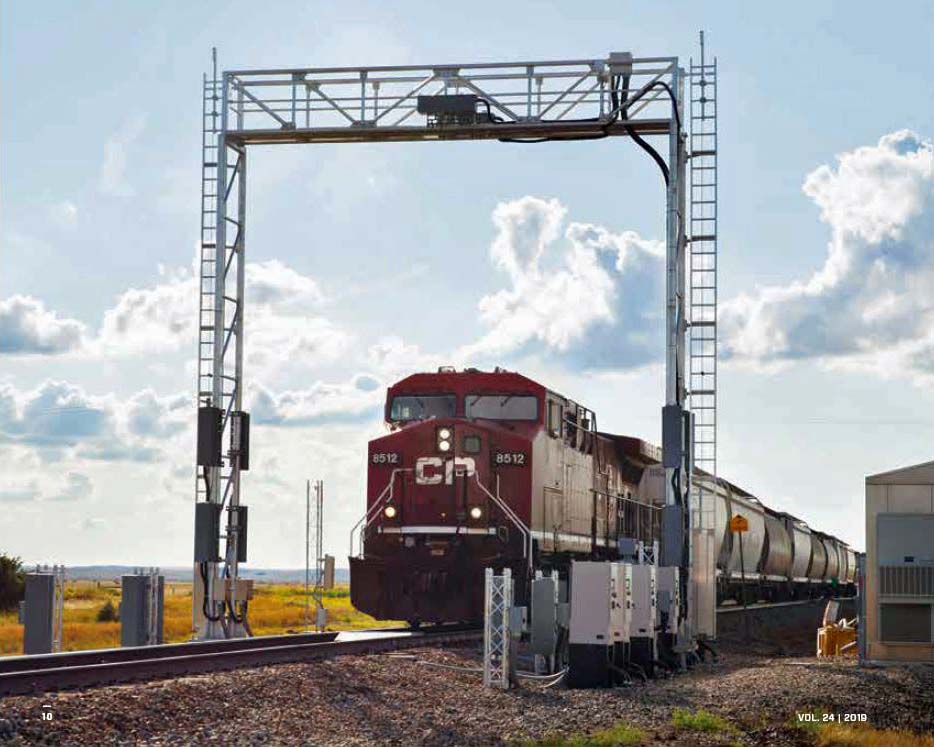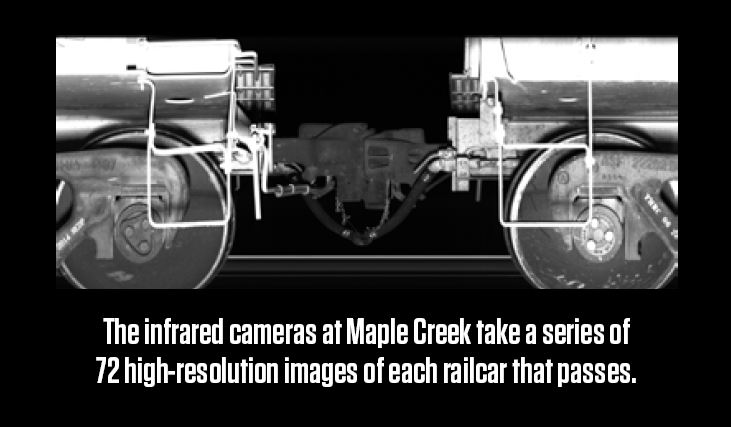

Canadian railroaders call it a P.K. and U.S. railroaders, a roll-by. By any name, they're referring to a critical safety check, and most of us have done it more times than we can count. We watch, listen to, and smell a passing train, straining our senses for anything that might be amiss.
Amid the farm fields outside Maple Creek, Saskatchewan, CP is taking the visual aspect of a P.K. to the next level. The gantry system that rose up over the tracks this summer is enabling inspectors to see railcars with a perspective and level of detail that's never been possible before.

"We do a very good job at CP of looking at bearings, brakes, trucks, and wheels," said Solange de Blois, CP engineer in training.
A greater challenge, she said, has come in the form of harder-to-see components, such as carrier plates, missing bolts, coupler keys, and other
parts, many of which reside at the frame level and higher. Currently, CP depends on rail car inspectors driving alongside stopped trains in
all-terrain vehicles to identify them.
The infrared cameras at Maple Creek take a series of 72 high-resolution images of each rail car that passes. The cameras focus from above and below, and at the sides of rail cars from multiple elevations. Inspectors in the office examine and analyze the resulting black and white photographs for anything that might be amiss.

"The idea is to capture 360 degrees of the train," De Blois said. "You can verify the handbrake. You can even see the paint
on the handbrake chain. You can see the tabs and the bolts. You can see the brake shoe, the springs and the truck as a whole. You can zoom in on
these images, draw on them, and save them. It's really a game-changer for us."
Step one of the new camera system commenced in July, when inspectors began analyzing photographs of passing potash trains. CP plans to ask Transport Canada for an exemption from some traditional terminal train inspections to test the efficacy of the new system. If it is successful, the test could push beyond the potash fleet, to new sites elsewhere on the CP system.
De Blois said that development of future systems should be easier now that the initial model is up and running. "A lot of this is very customized. We had to do it from the ground up," she said. "We're dealing with several types of systems here, hose, truck view, train view, the gantry. We never do single-track signal bridges." Additional challenges include building a system on a high water table that will stand up to stiff prairie winds, limited communications infrastructure, and the need to clear the occasional high and wide load. The Maple Creek gantry system is a model for future systems.

WRITERS & CONTRIBUTORS Jeremy Berry, Christine Brown, Ariella Calin, Andy Cummings, Vanessa DiFruscia, Brenda Land, Mallory McCredie, Adam Meeks, Melissa Murray, Leah Ryan, Salem Woodrow
DESIGN Geminesse Johnson
ILLUSTRATION & PHOTOGRAPHY Jon Evans, Kris Grunert, Danny Schlitz, Sean Stewart, Amanda Tessmann, Fritz Tolentino, John Woods, Neil Zeller
The goal of all this, said Kyle Mulligan, CP's Chief Engineer, is to catch more defects than is currently possible. This holds the promise of preventing mechanically caused derailments. It also gives CP the opportunity to identify rail cars that need to be set out before a train gets to a terminal, enabling an opportunistic set-out on arrival, saving time. Finally, this means more work for mechanical shops.
"Our employees out there on the ground, instead of spending the majority of their time inspecting, they're going to spend the majority of their time repairing," said Mulligan, "which is going to bring that expertise back into our shops."
Mulligan offered one other key advantage the Maple Creek gantry system offers over terminal inspections. "We're assessing the train in its natural state, which is in motion," he said. "When we have static inspections, how do we know if the draft gears are working as they should? This detector is on flat ground, so the entire train is going to be in draft. If those draft gears are extending more than they should, we'll see that."
Just like an old-fashioned P.K. Except, the new system offers a comprehensive, detailed, look at every inch of every rail car from every angle. It's part of the future of the technologies that will help maintain CP's industry-leading safety record into the future.
